Thangka Painting
The Thangkas of The Tibetan Medicine
Created between 1687 and 1703, these thangka paintings were commissioned by the fifth Dalai Lama’s regent, Desi Sangye Gyatso, who stepped in as interim ruler of Tibet after the Dalai Lama died in 1682.
The paintings constitute the charts of The Blue Beryl, a text written by Gyatso as commentary of the Four Tantras, the fundamental text of Tibetan medicine.
The main reason that moved Gyatso to create this illustrations was to avoid confusion when interpreting old texts.
Gyatso placed great value on the accuracy of the illustrations depicting such things as the use of omens and dreams for making diagnoses, hundreds of medicinal herbs and medical instruments, and fabulous diagrams of human anatomy.
As stated by the International Academy for Traditional Tibetan Medicine (IATTM) “one of the unique features of Traditional Tibetan Medicine is that it contains a comprehensive philosophy, cosmology, and system of subtle anatomy with associated spiritual practices”.
Today these Thangkas constitute a fundamental piece of educational art that interweave Tibetan Buddhist traditions with centuries-old medical knowledge.
The first painting occupies a privileged place among the others which, in a certain sense, derive from it. It represents the celestial city of the Buddha Bhaisajyaguru, Master of Remedies “Surdasana”. The city is surrounded by four “mountains”. Further more it is square with the palace at its center. The palace, like the whole locality, is an emanation of Buddha Bhaisajyaguru. Its plan evokes a Mandala, with its square enclosure and its four gates oriented in the cardinal directions.
The thangkas not only depict the Buddhist background of Tibetan medicine but also the diagnostic schemes of pulse and urine analysis, picturesque representations of dietary and behavioral advice for treating illnesses, as well as anatomical knowledge,charts for moxabustion, and the elaborate “materia medica” of Tibetan pharmacology.
In fact Twenty-one Thangkas of the original series are devoted to more large human figures illustrating anatomical structures.
The first fifteen compositions have a top register. The registers contain the four main sequential topics relating to the origin myths and state narrative on the Tibetan History of Medicine of the late 17th century.
There are four main sequential topics contained in the registers:
– Medicine Buddha and early Indian Gods and Rishis.
– The Lineage of the Four Medical Tantras.
– The Yutog Nyingtig Lineage.
– The Deities and Protectors of the Yutog Nyingtig.

Follow traditionalartofnepal.com on WordPress.com
Raktayamari Thangka: A Closer Look at the Thangka Worth $45 Million
Overlook
Widely recognised as one of the most important Asian works of art and one of the world’s great textile treasures, this Thangka was recently bought for $45 million.
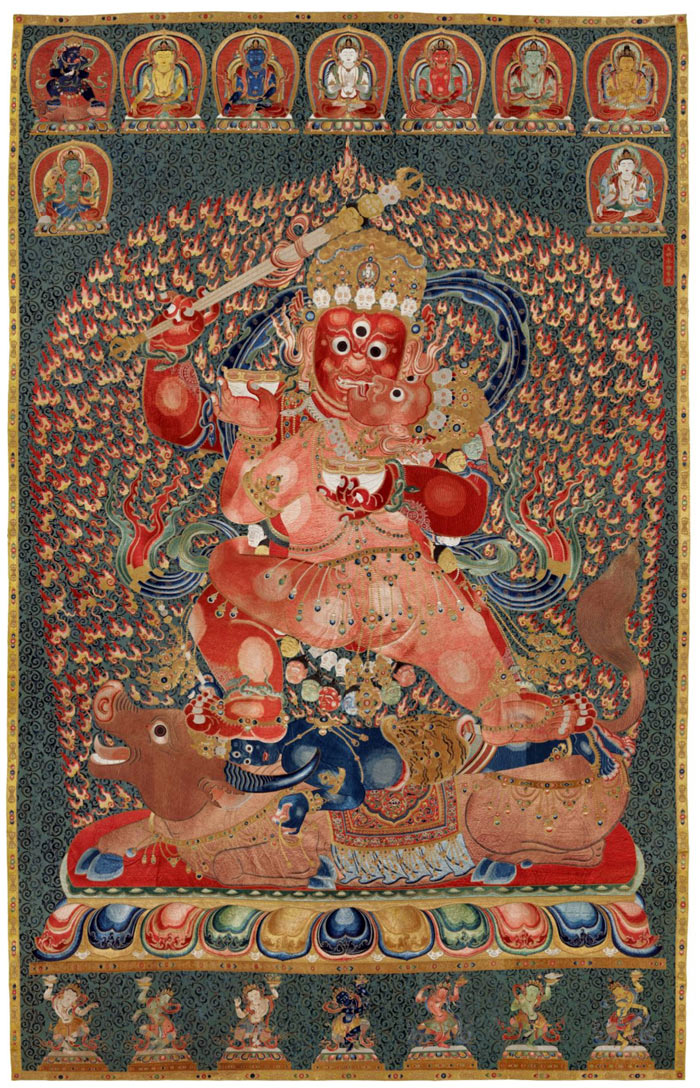
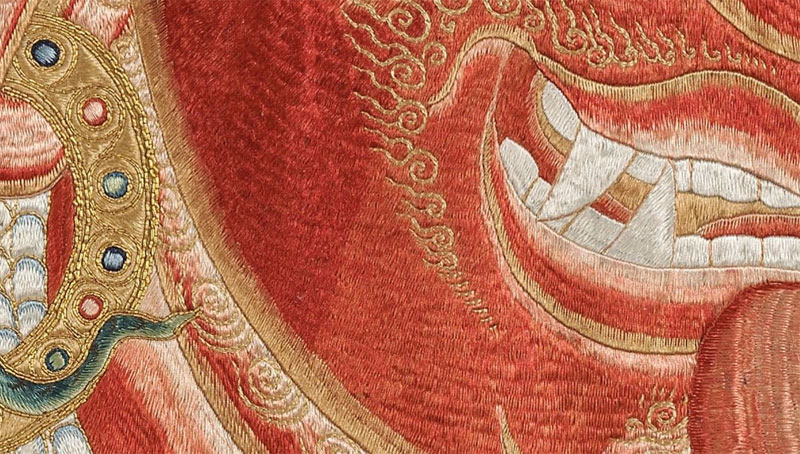
The Thangka depicts the majestic Raktayamari, the red Conqueror of Death, standing in yab-yum embracing his consort, Vajravetali.
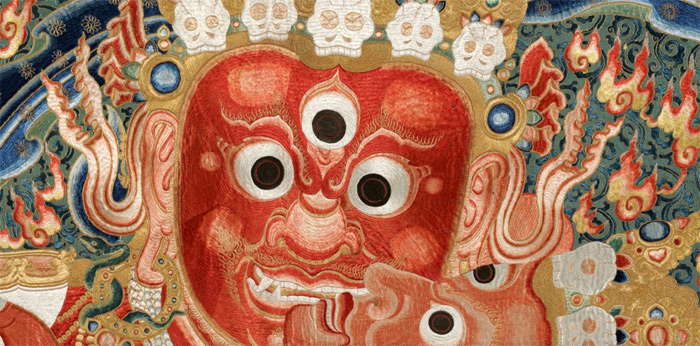
Raktayamari is an important deity of Anuttarayoga-Tantra in Vajrayana Buddhism, and one of the three Yamari forms of Bodhisattva Manjusri (the other two being Vajrabhairava and Krishna-Yamari) revered by various Tibetan sects.
The highlights on the torsos and limbs of Raktayamari and Vajravetali, to denote the musculature, are some of the most common motifs in Nepalese-Tibetan paintings and a notable characteristic of figures in classical Tibetan art.
Highlights and Symbolism
Every aspect of the form of Yamari and the consort Vajra Vetali have symbolic and coded meaning.
The red body color represents the desire to overcome all sufferings and place all beings in the state of enlightenment. The weapon that Raktayamari holds subdues the afflictions (maras).
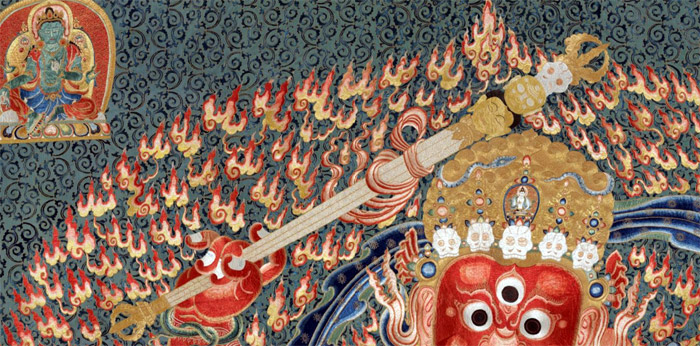
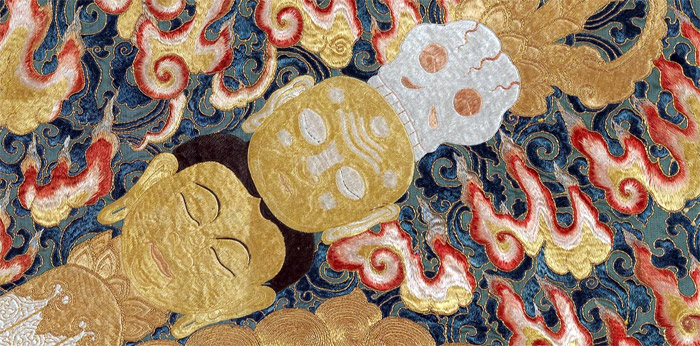
The left hand holds a cup made by ancient Lama’s skull and containing the essence of the four maras transformed.
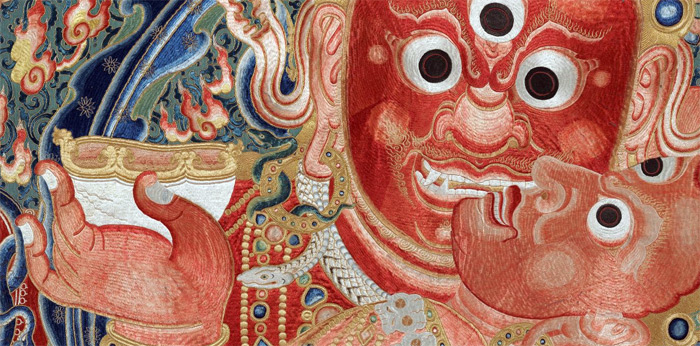
The three round eyes express compassion for all beings in the three times of past, present and future as well as the three watches of the day and three watches of the night.
The orange and red hair is to symbolize the increasing qualities of the Buddha and the aspects of the Mahayana Five Paths.
The crown of five dry skulls symbolizes the five poisons transformed into the five wisdoms.
The necklace of fifty fresh heads represents the vowels and consonants of the Sanskrit language.
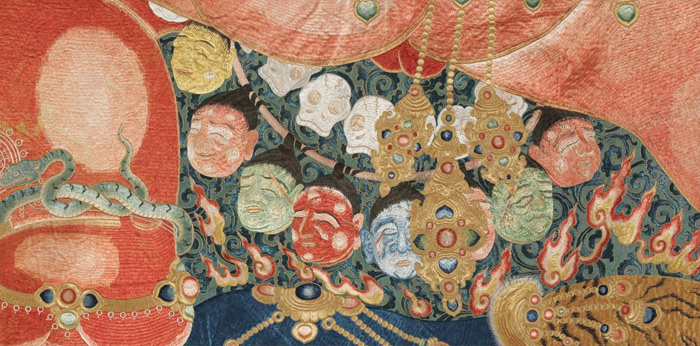
The eight snakes represent the subjugation of various obstacles and the accomplishment of skillful activities.
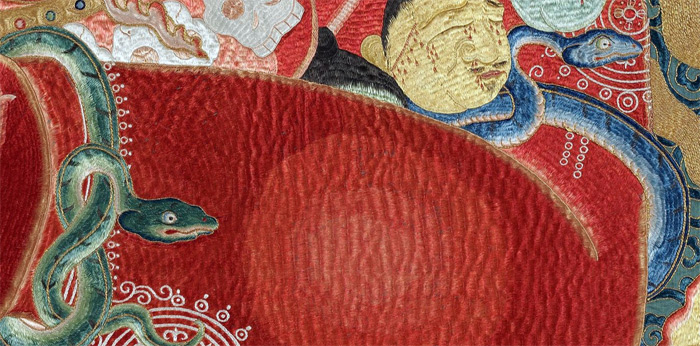
The locked couple is trampling on the blue corpse of Yama, the Lord of death, wearing a tiger skin and crown, lying on the back of their mount, a brown buffalo recumbent on a multi-coloured lotus base.
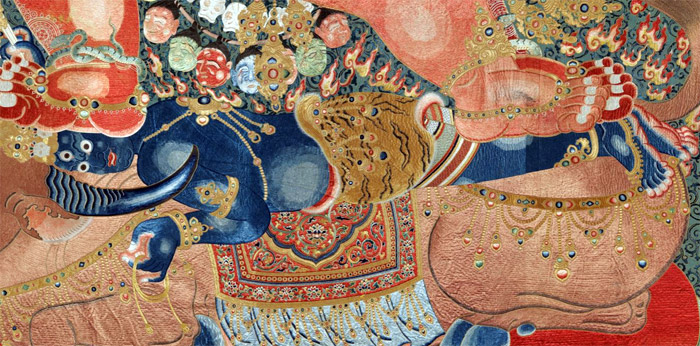
All below two rows of buddhas and bodhisattvas seated on lotus bases, the upper including Heruka Vajrabhairava on the far left and Manjusri on the far right, flanking the five Dhyani Buddhas.

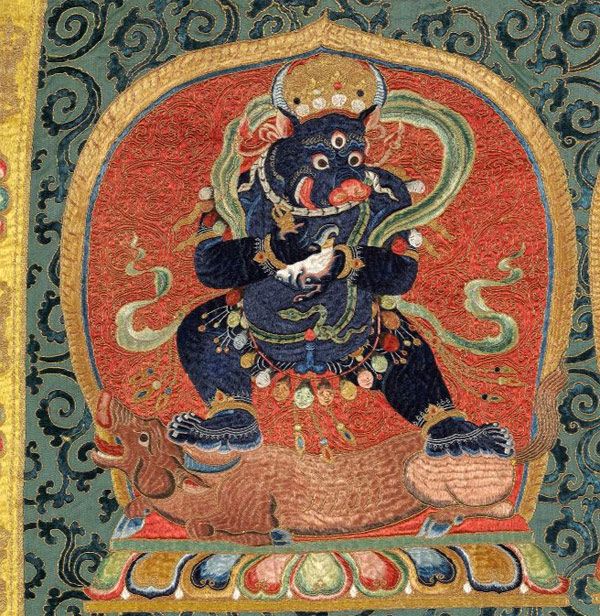
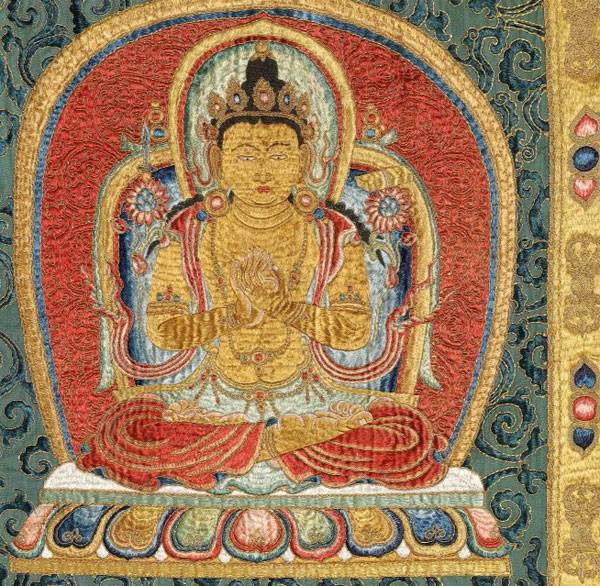
Below this row of deities are two Taras – Green Tara on the left, and White Tara on the right.
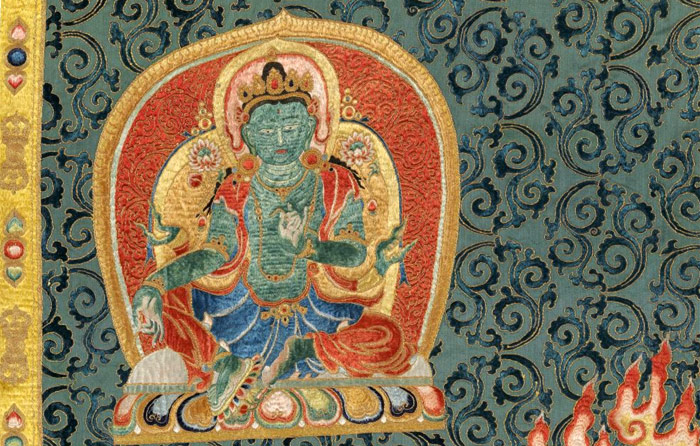
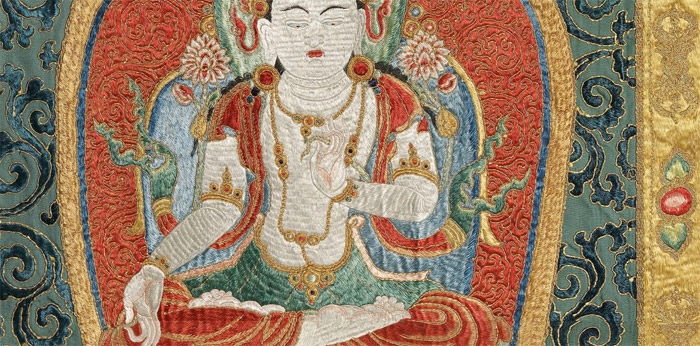
In the lower panel is a row of seven offering goddesses dancing on lotus bases and holding aloft dishes as offerings below the couple.
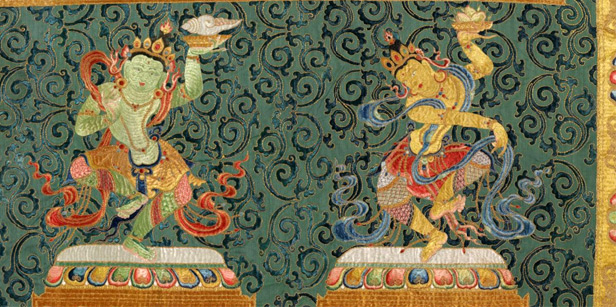
Meaning of the artwork
The metaphor for Rakta Yamari is ‘death.’ The name means the ‘Red Killer of Death.’
In this symbolic meaning the idea of death refers directly to the suffering and unhappiness in the world as described in Buddhist philosophy.
The general appearance of the deity, number of faces, arms, ornaments, decorations and attributes are all part of a mnemonic device (memory system) that incorporates the most essential of Buddhist principles and core teachings into a single object.
The one face represents the embodiment of the wisdom of all Buddhas as having one taste, or flavor, ultimate truth. The red body color represents the desire to overcome all “maras” and place all beings in the state of enlightenment.
Bibilography
Henss, Michael. ‘The Woven Image: Tibeto-Chinese Textile Thangkas of the Yuan and Early Ming Dynatsies’, Orientations, November 1997.
Himalayan Art Resources. Rakta Yamari Main Page. http://www.himalayanart.org/search/set.cfm?setID=349. Jeff Watt, 2-2005.
Himalayan Art Resources. Rakta Yamari Textile. HAR no. 57041. http://www.himalayanart.org/image.cfm/57041.html.
Raktayamari-tantraraja-nama. Gshin rje’i gshed dmar po zhes bya ba’i rgyud kyi rgyal po [TBRC w25383, w25384].
Reynolds, Valrae, ‘Buddhist Silk Textiles: Evidence for Patronage and Ritual Practice in China and Tibet.’ Orientations, April 1997.
George Roerich (trans.), Biography of Dharmasvamin, A Tibetan Monk Pilgrim. Patna: K.P. Jayaswal Research Institute, 1959.
George Roerich (trans.), The Blue Annals. Delhi: Motilal Banarsidas, 1996, 2nd ed.

Follow traditionalartofnepal.com on WordPress.com
The Wheel of Life Explained
The Wheel of Life or “Bhavacakra” is well known by Buddhist monks as a powerful meditation tool and also by students to learn and understand the teachings of the Buddha. The Wheel represents the very reasons for the suffering of our mortal form, through both horrific and sublime imagery and it can be seen painted on the walls of many Tibetan Buddhist monasteries in all Himalayan regions. 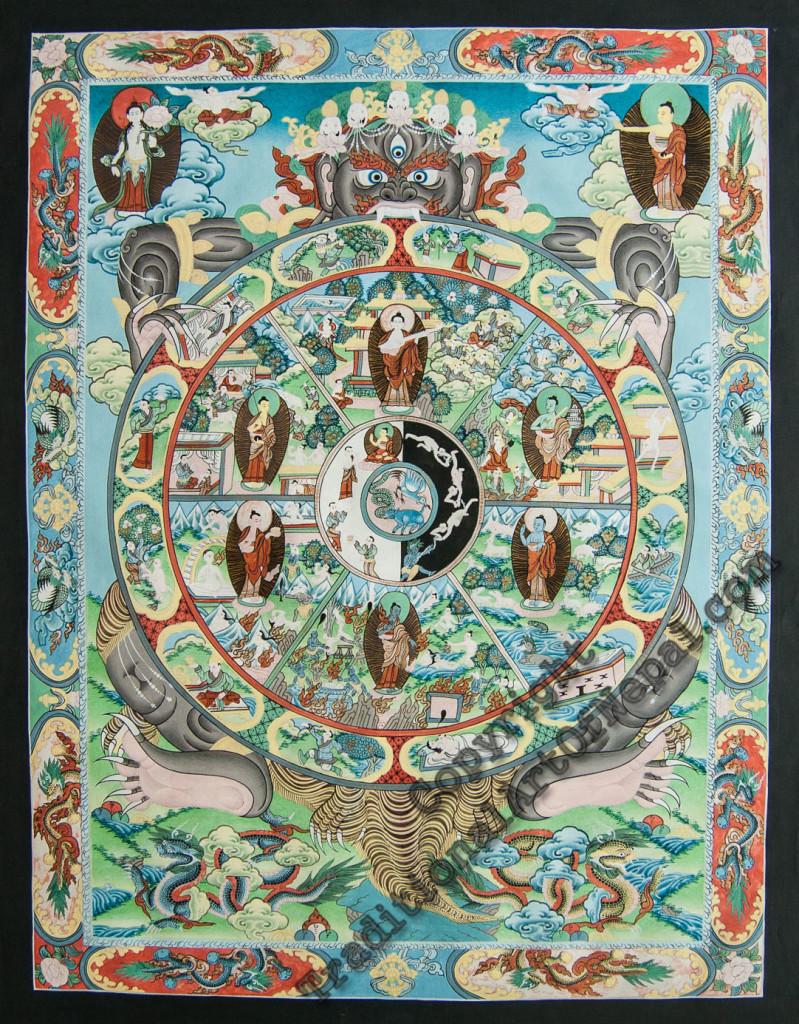
Essentially it is a metaphysical diagram made up of four concentric circles, held with a firm grip by Yama, the Lord of Death.
Above the wheel the sky with clouds or stars is symbol of freedom from cyclic existence or Samsara, and the Buddha pointing at it indicates that liberation is possible.
In the center of the wheel there are three animals symbols of the “Three Poisons”: ignorance (the pig), attachment (the bird) and anger (the snake).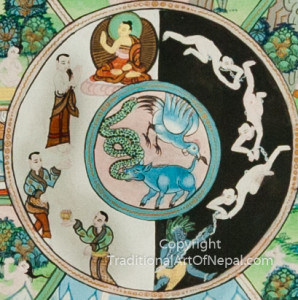
The snake and bird are shown as coming out of the mouth of the pig, indicating that anger and attachment arise from ignorance. At the same time the snake and the bird grasp the tail of the pig, indicating that they both promote even greater ignorance.
Next to the central circle is the second layer divided in two-half circles, one light colored while the other is usually dark.
These images represent the wheel of Karma, the law of cause and effect.
The darker portion shows individuals experiencing the results of negative actions. The light half circle, instead, indicates people experiencing the results of positive actions and attaining spiritual ascension.
Beyond this layer is a wider area divided into six parts, each depicting a different realm of Samsara.
These six realms constitute all possible states of existence in the universe and all beings cycle between these states.
They can be divided into higher realms and lower realms.
The three higher realms are:
1). The Human Realm
The human realm is the world of everyday experience.
Human life, containing both pleasure and pain, makes us aware of both these aspects of life. Buddhism teaches that such harmonious balance give us the opportunity to pursue spiritual realization, this is the reason why human world is considered to be the most suitable realm for practicing the dharma.
2). The Semi-Gods Realm
The titans that live in this realm, not content with what they possess, spend their time fighting among themselves or making war to the gods.
These semi-gods do not suffer from desire or greed but from constant fighting and jealousy.
3). The Realm of the Gods
These gods are pictured like beings not so far from the human dimension in fact they share similar sensuous experiences.
The gods enjoy lives full of abundance and pleasure however they spend their existence pursuing meaningless distractions and never think to practice the dharma. This way they deplete their good Karma and they will suffer through being reborn in the lower realms.
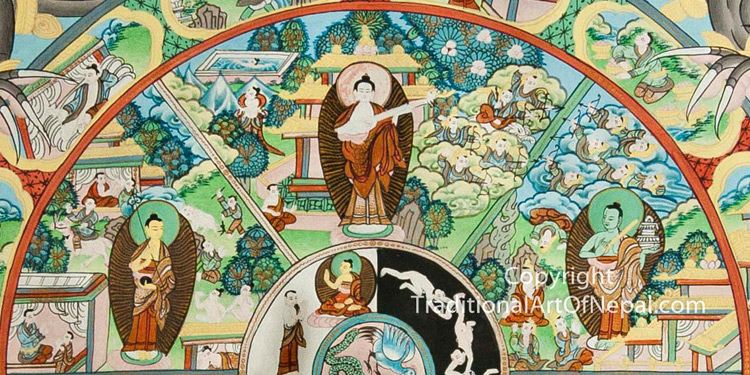
The three lower realms are:
4). The Hell Realm
The hell is typically represented as a places of intense torment where beings endure unimaginable suffering. The victims are subjected to the most terrible tortures inflicted by demons.
In the Buddhist tradition there are eighteen “hells” that can be hot or cold.
5). The Hungry Ghosts Realm
This realm is inhabited by pathetic creatures with suffering from extreme and perpetual hunger and thirst.
They wander constantly in search of food and drink, however even if they get what they want it will cause them intense agony.
6). The Animals Realm
In this realm life is based on self-preservation. Animals live in constant fear and suffer from being attacked and eaten by other animals. Metaphor of refusal to see beyond the physical needs.
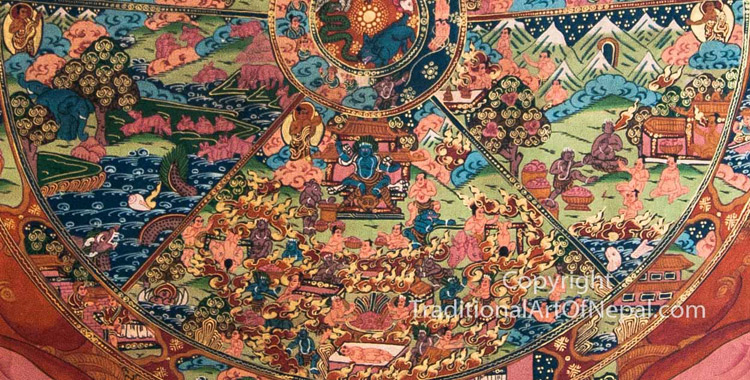
Depicted inside each realm, in some wheel of life representations, there is a Buddha or bodhisattva trying to help the beings living in that realm to find their way to nirvana.
The outermost concentric ring of the Wheel of Life present the process of cause and effect in detail.
The circle is divided into twelve parts, each depicting a phase of the law of Karma which keeps us trapped in the six realms of cyclic existence.
The twelve causal links and the correspondent allegories are:
Avidyā: Ignorance – a blind man, often walking.
Saṃskāra: Mental Formations – a potter shaping a vessel.
Vijñāna: Consciousness – a man or a monkey grasping a fruit
Nāmarūpa: Name and form – two men afloat in a boat
Ṣaḍāyatana: Six senses – a dwelling with six windows
Sparśa: Contact – two lovers kissing or entwined
Vedanā: Feeling – a men with an arrow in the eye
Tṛṣṇa: Craving – a drinker receiving drink
Upādāna: Grasping – a man or a monkey picking fruit
Bhava: Existence – a couple engaged in intercourse or a standing reflective person
Jāti: Rebirth – a woman giving birth
Jarāmaraṇa: Aging and Death – a corpse being carried
Bhavacakra Thangka paintings usually contain an inscription on the bottom explaining the process that keeps us in Samsara and how to reverse that process according to the teaching of the Buddha that said:
I have shown you the path that leads to liberation
But you should know that liberation depends upon yourself.
The Wheel of Life is also known as:
- Wheel of becoming
- Wheel of cyclic existence
- Wheel of existence
- Wheel of rebirth
- Wheel of Saṃsāra
- Wheel of suffering
- Wheel of transformation
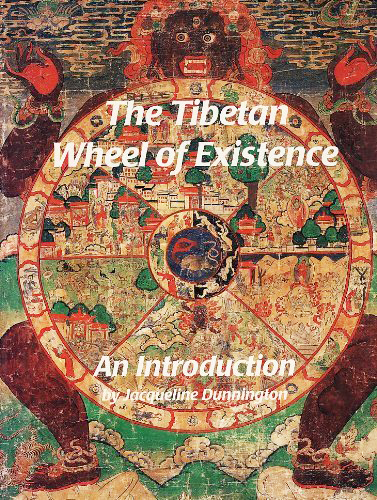
The Himalayan Times: Sacred Nepali art losing colors
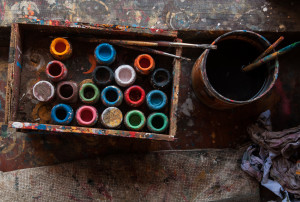 Extract from thehimalayantimes.com
Extract from thehimalayantimes.com
One of the traditions Nepal can really pride itself upon is the art of thangka paintings — which are so exquisite that foreigners have been known to extend their stay to learn the techniques. However, the rise of unhealthy competition, lack of regular-isation and emigration of artists is posing a threat to the inventive profession. Thangka is a Tibetan silk painting with embroidery, usually depicting a Buddhist deity, famous scene, or mandala. It is done on cotton canvas — found in Asian countries such as Tibet, Nepal, Bhutan, India and Mongolia — used exclusively for this purpose. Native Buddhists of Kathmandu valley call it ‘pauva chitra’ whereas it is also known as ‘tangka’, ‘thanka’, or ‘tanka’.
These paintings lucidly represent Buddhist deities and divinities that appear in sacred Buddhist practices called ‘sadhana’. This means artists are not allowed to use their imagination. There is also a belief that thangka emanates positive vibrations and good luck. “Thangkas may merely seem like beautiful and luxurious showpieces for those who are unaware about Buddhist beliefs. But for Buddhists, it is a sacred tool for meditation and purification of the soul,” says Anil Ghising, general secretary of Thangka Traders Association (TTA).
The most popular thangka designs include mandala, wheels of life and life of Buddha. They can be divided into three categories according to the quality — student piece, medium piece, and master-piece. Student piece is the work of a practitioner with a year’s experience, medium piece is the work of an artist who has over five years of experience, whereas master-pieces are created by artists with over 15 years of experience in thangka painting.
This is the major reason for the difference in the prices of similar-sized thangkas. The lack of uniformity in prices also depends upon size, art, toil and materials used. The price of thangkas begins at around Rs 500 and goes up to millions of rupees.
Meanwhile, Hajar Singh Lama, president of TTA, laments about the unhealthy competition in the market. He says, “The trend of pre-set contract with tourist guides is the major reason for such competition. Tourists are compelled to buy thangkas at the store specified by the guide, which is akin to deception.” According to him, the best way to stabilise the business is to draft and implement regulations for establishing thangka shops. Thamel, Bhaktapur and Boudha are the core areas for buying thangkas, whereas one can get them at Patan, Swoyambhu and Changu Narayan as well. According to TTA data, 222 thangka galleries function from Kathmandu valley, of which 72 are in Thamel.
Anil informs that the process of making thangka is very tedious. “An artist needs to meditate before starting his piece. Patience and dedication are essential to complete the assignment, which I feel is lacking in the new generation,” he says. Worried about the future of the industry, he suggests the government to include thangka and Buddhist scroll paintings in academia. He adds, “Thangka artists are gradually migrating to foreign lands, which threatens survival of the entire business. The government should carry out concrete work if it wants traditional art to be preserved for future generations.”
Another complaint of thangka artists is the lack of increment in business during ongoing Nepal Tourism Year. “The number of tourists has increased, but since majority of tourists come on special packages, our business has not fostered as we’d hoped,” laments Akka Lama, owner of Tibetan Thanka and School of Thanka Painting at Thamel. According to him, global economic crisis, political instability, and insecurity are main causes for the annual decline in business. However, Lama optimistically says, “The country can benefit from the tourism industry, if the government and concerned professionals concentrate on reducing the challenges and work towards making Nepal a tourist-friendly destination with ample facilities and attractions — one of them being thangka.”
Agreeing with this, Narayan Shrestha, owner of Traditional Art and Handicraft at Patan, says, “Our business relies upon foreigners, so the government should plan well to attract budget tourists.”
He opines that various ministries need to join hands to uplift thangka, tourism, and the nation as a whole.
SUJATA AWALE

Follow traditionalartofnepal.com on WordPress.com
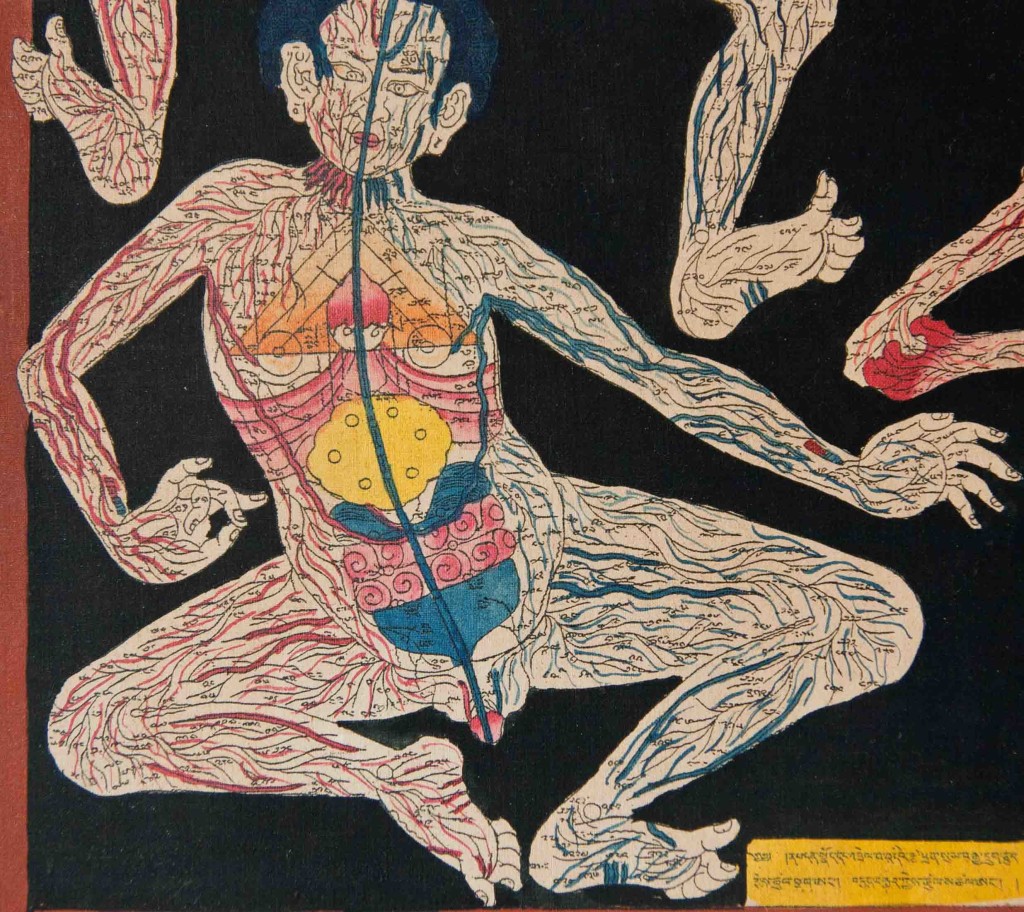
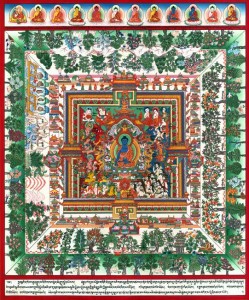
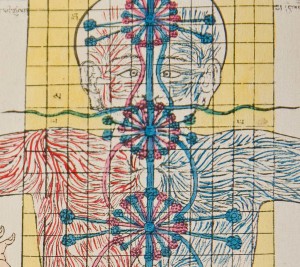
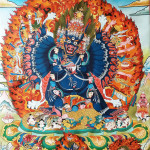 Vajrabhairava
Vajrabhairava 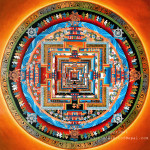 Kalachakra Mandala
Kalachakra Mandala 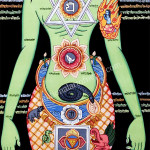 Chakraman Yogi
Chakraman Yogi 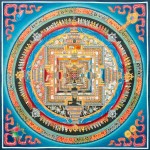 Kalachakra Mandala Auspicious Symbols
Kalachakra Mandala Auspicious Symbols 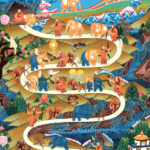 Samatha Meditation Thangka
Samatha Meditation Thangka 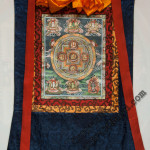 Silk Frame #02
Silk Frame #02 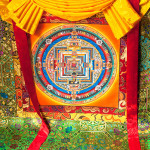 Modern Design Brocades
Modern Design Brocades 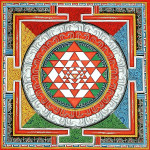 Sri Yantra Mandala
Sri Yantra Mandala 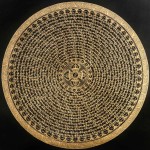 Yin Yang Mantra Mandala
Yin Yang Mantra Mandala 





